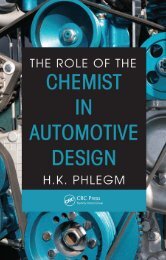Lightweight Electric/Hybrid Vehicle Design
Lightweight Electric/Hybrid Vehicle Design
Lightweight Electric/Hybrid Vehicle Design
Create successful ePaper yourself
Turn your PDF publications into a flip-book with our unique Google optimized e-Paper software.
xxii <strong>Lightweight</strong> <strong>Electric</strong>/<strong>Hybrid</strong> <strong>Vehicle</strong> <strong>Design</strong><br />
Lean production is the approach pioneered by Toyota in which the elimination of unnecessary<br />
steps and aligning all steps in a continuous flow, involves recombining the labour force into<br />
cross-functional teams dedicated to a particular activity, such as reducing the weight of an EV<br />
platform. The system is also defined by the objective of continually seeking improvement so that<br />
companies can develop, produce and distribute products with halved human effort, space, tools,<br />
time, and, vital to the customer, at overall halved expense.<br />
Enterprise structures aim to exploit business opportunities in globally emerging products and<br />
markets; to unite diverse skills and reapply them in long-term cooperative relationships; to allocate<br />
leadership to the member best positioned to serve the activity involved regardless of the size of<br />
company to which he/she belongs; and finally to integrate the internal creation of products with<br />
the external consequences of the product. In EVs this would involve ensuring an adequate<br />
operational infrastructure be provided by an electricity generating company, in combination with<br />
local authorities. The products involved are those, such as the electric vehicle, that no one member<br />
company on its own could design, manufacture and market. Partners in an EV enterprise might<br />
also lead it into additional businesses such as power electronics, lift motors, low cost boat-hull<br />
structures and energy storage systems for power station load levelling, for example. Internally the<br />
use of combined resources in computer software technology could be used to develop simulation<br />
packages that would allow EVs to be virtual tested against worldwide crashworthiness standards.<br />
Managing of product external consequences could be facilitated by forming partnerships with<br />
electricity generators, material recyclers and urban planners, finance, repair and auto-rental service<br />
suppliers as well as government agencies and consumer groups.<br />
0.3.1 COOPERATIVE NETWORKS<br />
Unlike the Japanese networks of vertically integrated companies, such as the supply chains<br />
serving Toyota, an interesting Italian experience is one of horizontal networking between<br />
practitioners in specialist industries. Groups of small companies around Florence, in such areas<br />
as food processing, furniture making, shoe manufacturing, have been unusually successful and,<br />
in the case of tile manufacture, have managed to win an astonishing 50% of the world market.<br />
Export associations have been formed on behalf of these small companies and at Modena even<br />
a finance network has been formed between companies in which the participants guarantee one<br />
another’s bank loans. The normal default rate of 7% for bank loans in this region has become<br />
just 0.15% for this industrial network, demonstrating the considerable pride built up by companies<br />
in meeting their repayment obligations. Commentators liken the degree of trust between<br />
participants as being akin to that between different branches of traditional farming families.<br />
Like the grandfathers of the farming families the ‘elders’ of the industrial networks offer their<br />
services for such tasks as teaching apprentices in local colleges. The secret, some say, is that<br />
these areas around Florence escaped the era of Fordism which affected northern Italy and many<br />
other industrial centres of Europe.<br />
The approach to setting up such a network is to build on elements of consensus and<br />
commonalilty so as to create mutual facilities of benefit to groups of small companies wishing<br />
to compete successfully against the international giants. Generally a network has a coordinating<br />
structure of interlinked elements which are individuals, objects or events. The links can be in<br />
the form of friendship, dependence, subordination or communication. In a dense network<br />
everyone knows everyone else while some networks may, for example, comprise clusters of<br />
dense elements with ties between clusters perhaps only involving one individual in each. The<br />
specific definition of a network is the set of relations making up an interconnected chain for a<br />
given set of elements formed into a coordinating structure.







